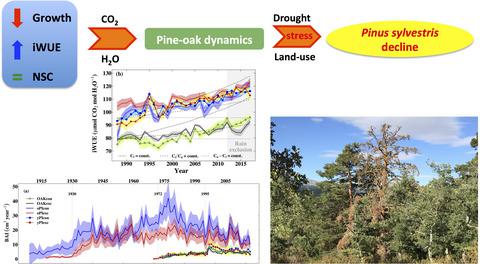Our official English website, www.x-mol.net, welcomes your feedback! (Note: you will need to create a separate account there.)
Contrasting species decline but high sensitivity to increasing water stress on a mixed pine–oak ecotone
Journal of Ecology ( IF 5.5 ) Pub Date : 2020-06-20 , DOI: 10.1111/1365-2745.13450 Guillermo Gea‐Izquierdo 1 , Ismael Aranda 1, 2 , Isabel Cañellas 1 , Isabel Dorado‐Liñán 3 , Jose Miguel Olano 4 , Dario Martin‐Benito 1
中文翻译:

相反的物种减少,但是对松-橡树混交林交错带的水分胁迫高度敏感
更新日期:2020-06-20
Journal of Ecology ( IF 5.5 ) Pub Date : 2020-06-20 , DOI: 10.1111/1365-2745.13450 Guillermo Gea‐Izquierdo 1 , Ismael Aranda 1, 2 , Isabel Cañellas 1 , Isabel Dorado‐Liñán 3 , Jose Miguel Olano 4 , Dario Martin‐Benito 1
Affiliation

|
- Forest decline under environmental stress is expressed by regeneration failure and accelerated mortality in all ontogenic stages at the population level. Characterizing functional traits and mechanisms that best capture species decline and mortality is essential to assess forest dynamics.
- We analysed sensitivity to increasing water stress in two species with different water‐use strategies on a mixed Quercus pyrenaica–Pinus sylvestris forest where adult pines express vulnerability to climate change but oaks do not. We compared the dynamics of radial growth, wood δ13C and sapwood non‐structural carbohydrates (NSCs) in response to drought at different time‐scales in both species and two age cohorts in pine.
- Both species were very sensitive to water stress, which influenced trait phenotypic plasticity at short‐ and long time‐scales. Water‐use strategy in pines of both ages was more conservative than in the more drought‐tolerant oak. Both species showed negative growth trends despite increasing intrinsic water‐use efficiency. Recent growth of pines is slower than it was in the past. Carbon isotope discrimination trends in young pines suggested increasing leaf gas exchange constraints. NSCs were far from depletion in both species and all pine ages. Intra‐ and inter‐annual NSC variability was higher in oaks than in pines and in soluble sugars (SS) than in starch. SS were lowest in young pines. Sensitivity of NSCs to contrasting climatic years was low in pines, and NSC levels mostly remained homeostatic for this species. The sensitivity to climate expressed suggests different C allocation strategies, with less coupling between radial growth and current‐year photosynthesis in young pines.
- Synthesis. Pines expressed negative responses to increased water stress regardless of age, showing rising gas exchange constraints through tighter stomatal control of water losses than oaks. Young pines showed similar functional responses to water stress than old pines in decline, which suggests species‐level vulnerability and could be regarded as early warning signals anticipating mortality in pines. Yet, given the high sensitivity to drought also expressed by the non‐declining oak, it would have been difficult to unequivocally disentangle species decline based only on the functional traits analysed.
中文翻译:

相反的物种减少,但是对松-橡树混交林交错带的水分胁迫高度敏感
- 环境压力下森林的退化表现为种群水平上所有个体发育阶段的再生失败和死亡率的提高。表征最佳捕获物种减少和死亡的功能性状和机制对于评估森林动态至关重要。
- 我们在混合的栎-樟子松林中分析了两种采用不同水利用策略的物种对增加水分胁迫的敏感性,其中成年松树表现出对气候变化的脆弱性,而橡树则没有。我们比较了径向生长的动力学,木材δ 13 C和响应于干旱在物种和在松两个年龄组群不同时间尺度边材的非结构碳水化合物(神经干细胞)。
- 两种物种对水分胁迫都非常敏感,这在短期和长期都影响了性状的表型可塑性。与较耐旱的橡树相比,两种年龄的松树的用水策略都更为保守。尽管提高了内在用水效率,这两个物种均显示出负增长趋势。近期松树的生长比过去要慢。青年松树的碳同位素歧视趋势表明增加了叶片气体交换的限制。无论是在物种上还是在所有松树年龄中,NSC都没有耗尽。橡木的年内和年际NSC变异性高于松树,可溶性糖(SS)高于淀粉。SS在年轻的松树中最低。松树中NSC对不同气候年的敏感性较低,并且该物种的NSC水平大多保持体内平衡。
- 综合。不论年龄大小,松树都对增加的水分胁迫表现出负面反应,这表明通过比橡木更严格的气孔控制水分损失,提高了气体交换约束。年轻的松树对水分胁迫的功能响应与衰老的松树相似,这表明物种的脆弱性,可以被视为预警松树死亡率的预警信号。然而,考虑到不衰落的橡树也表现出对干旱的高度敏感性,仅根据所分析的功能性特征就很难明确地消除物种的衰退。



























 京公网安备 11010802027423号
京公网安备 11010802027423号